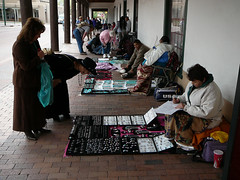
There isn’t anything more unsightly in perfectly-maintained downtown Santa Fe than the sandstone Civil War monument in its central plaza.
Many people in the oldest capitol in the United States hate it so much that they have called for it to be dismantled and reassembled in a much less visible location.
For historical purposes, though, “it should stay” in the heart of New Mexico’s government seat, Donna Padilla, a local historian, said while leading a group of tourists on a walking tour of the beautiful downtown district.
City officials are rather anal about what can be built in the city settled by Spain in 1598, when New Mexico’s first governor, Juan DeOnate, was sent here with 200 pioneers and 7,000 head of livestock.
New buildings can only be constructed in either the pueblo or territorial styles, no taller than three stories, and painted in any of the 40 approved earth tones. Pueblo buildings are low to the ground and often covered in mud-colored adobe or plaster, and the other approved buildings look similar, but have Greek Revival elements that were favored by U.S. residents who invaded the area in 1848 under President James Polk.

(Native Americans sell their wares, above, at the former governor's palace, one of the oldest remaining adobe buildings in downtown Santa Fe)
Judging by the number of misspelled words in the white marble tablets embellishing four sides of the war monument, it’s no wonder it embarrasses some of those who take such great pride in the city’s appearance.
February is spelled wrong in the side that pays tribute to Union soldiers who lost their lives in the 1862 Battle of Valverde, when Confederate troops conquered Santa Fe.
April was originally spelled in Abril – the Spanish word for the month - in another side honoring Union soldiers who were killed a month later when the rebels were forced out of town. The word was carved out, leaving a deeper impression in the marble, allowing the month to be respelled in English.
The first few words in a third tablet about the territorial war with Native Americans must have been disliked because they, too, were filed off and replaced with “TO THE HEROES.” Then, in 1974, a mysterious man walked up to that side and chiseled off the adjective, “savage,” that had been used to describe the Indians.
No one asked any questions because the man wore a hardhat, as if the city had hired him to work on the memorial, said Padilla, who is shown with the monument’s panel in the photograph above.
“To this day, we have no idea who took out the word savage,” she said. “You can look all over Santa Fe and you won’t find anything uglier than this monument.”

No comments:
Post a Comment